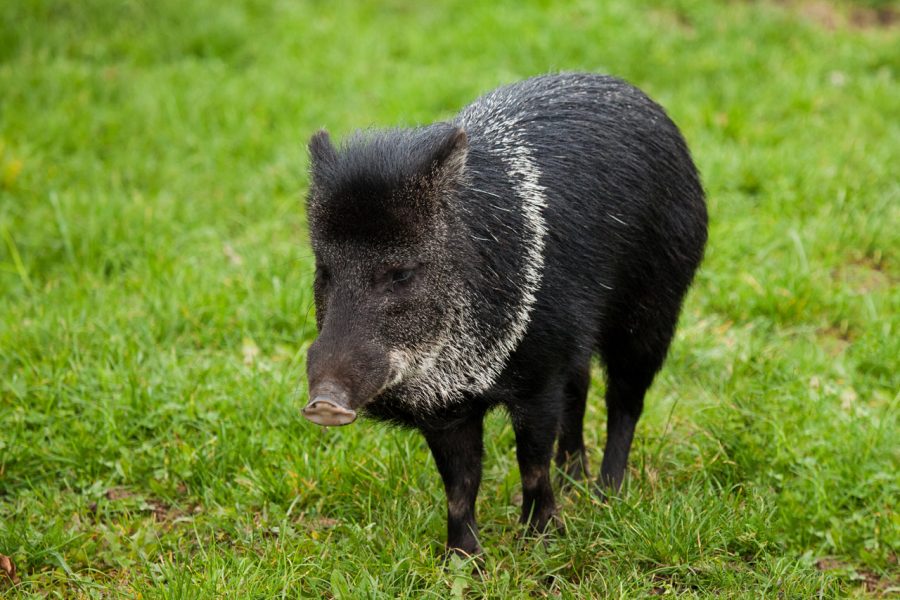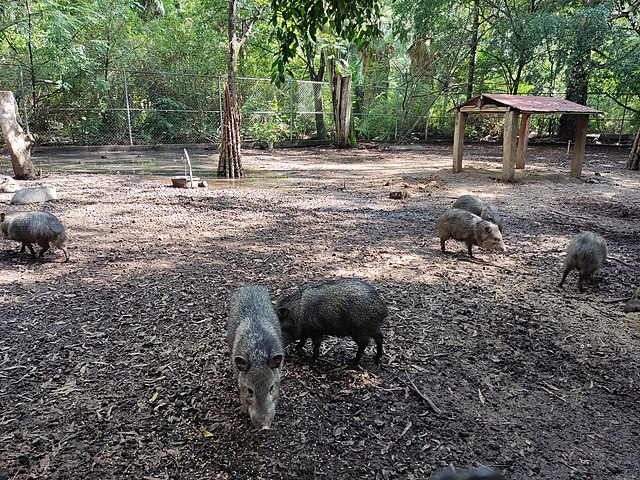
The peccary (Tayassu tajacu, Linnaeus 1758) is an ungulate mammal (animal with hoofed feet) that is part of the biodiversity of neotropical forests – including the Amazon – and is a wild species whose meat is an important source of protein for local communities.
A distinctive element of the Tayassu tajacu, with respect to other Peccaries, is the yellowish-white “collar” on its neck and back. Rengifo, et al. (2000) (6) point out that two biotypes of Tayassu tajacu have been identified: those with a wide “collar” and those with a thin “collar”.
Taxonomy of the peccary
According to López (2004) (4), on the zoological scale, the peccary belongs to the kingdom Animalia; Phylum: Chordata; Subphylum: Vertebrata; superclass Tetrapoda; class Mammalia; order Artiodáctyla; family Tayassuidae; genus Tayassu; and species Tayassu tajacu.
Other common names of the collared peccary
This mammal is also known as: Pecarí de Collar, Cerdo de Monte, Jabalí de collar, Taitetú, Coyámel, Saíno, Jabalina, Sajino, Chancho Rosillo, Zahino, Chácharo, Báquiro, among others.
Likewise, López (2004) (4) points out that in the indigenous Bora language it is known as ineeni; in the Aguaruna language as yugkioak (larger) and utsak (smaller); the Ticuna call it gnaxnam and in the Witoto language it is known as Mero.
Geographical distribution
According to Bodmer, et al. (1997) (1), Collared peccaries are the most widely distributed of the Amazonian ungulates; these mammals range from the southwestern United States and throughout Central America, encompassing the entire Amazon region, the Pacific coast of Colombia, Ecuador and Peru, and the Chaco of Paraguay, Bolivia, Brazil, and northern Argentina.
Wild pig habitat
This animal lives in a diversity of habitats, up to an altitude of 4,000 masl, including the deciduous forests of the Pacific coast, the dry and humid tropical forests of the Amazon and Central America, the Llanos, the Chaco, and the arid regions of Mexico and the southwestern United States (Bodmer, et al., 1997) (1).

Collared peccary at Morelia Zoo (Mexico) Source: NS777, CC BY-SA 4.0, via Wikimedia Commons
Description of the peccary (Tayassu tajacu)
The Collared Peccary is similar in morphology to a wild boar and domestic pig. It is a relatively small animal measuring approximately 90 cm, with a tail of 5 cm; reaching a height of 44 to 57 cm; it weighs between 20 and 30 kg. Its coat is long and thick, black or gray with a white spot in the form of a collar. Young individuals of this species are reddish brown during the first months of life and have a narrow black stripe along the back; as they age they change their coloration (Fundación Zoológico Santa Cruz, 2015) (3).
According to Diaz and Saenz (2000) (2), adult males of this species are distinguished from females by their size and long fangs, and they also have a cartilaginous tissue under the skin that serves as a shield. A striking feature of the Tayassu tajacu is the yellowish-white collar on its neck and back. On the other hand, these animals have a scent gland on their backs that secretes an oily substance with an intense musky odor, which evidences their presence in the area and also allows the identification between individuals of the herd, as well as the marking of the territory, rubbing themselves with logs and rocks, when they feel alarmed, which in turn is accompanied by the bristling of their hair.
Feeding
The peccary (Tayassu tajacu) feeds preferentially on all kinds of fruits that fall from trees, but its diet also includes flowers, tender plant stems and especially bulbs; they also eat roots and tubers that they dig up by digging the soil with their snouts. On the other hand, they consume invertebrates and small vertebrates such as frogs and snakes (López, 2004) (4).
Behavior
The Tayassu tajacu is a diurnal terrestrial animal that lives in small groups of approximately 3 to 20 individuals, showing a very sociable behavior among themselves, even in semi-captivity, which favors reproduction in these conditions. It sleeps at night in burrows or often under tree roots. His sense of sight is highly developed, but his sense of smell is weak. Sexual maturity is reached in the first year of age; the gestation period lasts from 156 to 162 days and gives birth to 1 to 3 offspring, usually twins (Universidad Politécnica Salesiana del Ecuador, n.d.) (6). The longevity of this species, in the wild, is approximately 15 years, but in captivity it can reach an age of 24 years (López, 2004) (4).

Main threats to the species Tayassu tajacu
In Peru, the Tayassu tajacu is a species that is not protected by the State and hunting is permitted as long as it is for subsistence purposes, but this is not enforced and it is quite common to find the meat and skin of this animal in Amazonian markets, putting the perpetuity of the species at risk (López, 2004) (4).
Peccaries, including the collared peccary, are the game species most in demand in the markets of the Amazonian cities; they are also of great importance in the international fur market. For example, in the city of Iquitos, capital of the Loreto region in the Peruvian Amazon, about 100 tons of Pecari tajacu bush meat is consumed annually. On the other hand, between 2007 and 2017, a total of 340,688 skins of this species were exported from Peru to the international market; this country is the only one in Latin America that is currently exporting Sajino skins, as a by-product of subsistence hunting. Indeed, peccaries contribute to generating economic income at the local, national and international levels (Pérez, et al., 2017) (5).
On the other hand, in addition to the threat posed by human hunting, the natural predators of the peccary are: Felis concolor (puma), Pantera onca (jaguar), Felis onca (jaguareré), Boa constrictor (boa) and the H.arpyja (harpy eagles) (López, 2004) (4).
References
- Bodmer, R., Aquino, R., Puertas, P., Reyes, C., Fang, T., and Gottdenker, N. (1997). Management and sustainable use of peccaries in the Peruvian Amazon. Quito: IUCN. Retrieved from https://portals.iucn.org/library/efiles/documents/ssc-op-018.pdf
- Díaz, E. and Saenz, E. (2000). Necklace sin. Retrieved from http://basica.primariatic.sep.gob.mx/descargas/colecciones/proyectos/red_escolar/publi_reinos/fauna/pecari_collar/pecari.htm.
- Santa Cruz Zoo Foundation. (2015). Collared peccary or Zaino. Retrieved from https://zoosantacruz.org/animales/pecari-de-collar-o-zaino/.
- López, M.C. (2004). Evaluation of the semi-captive behavior of Tayassu tajacu “Sajino” at the Centro Académico, Investigación y Ecoturismo – Biodiversidad- UNSM-T. Moyobamba: Universidad Nacional de San Martín-Tarapoto. Retrieved from https://repositorio.unsm.edu.pe/bitstream/handle/11458/2346/TP_IAMB_00022_2004.pdf?sequence=1&isAllowed=y.
- Pérez, P., et al. (2017). Population status of the peccary(Pecari tajacu) and Huangana(Tayassu pecari) in the Peruvian Amazon. Folia amazónica, 26(2), 103-120. Retrieved from http://www.iiap.gob.pe/Archivos/Publicaciones/Publicacion_3386.pdf
- Rengifo, M. E., Navarro, D., Flores, A., Rojas, P., and Gamarra, J. (2000). Intensive production of the collared peccary (Tayassu tajacu, Linnaeus 1758) in the Peruvian Amazon (Loreto, Peru). Conocimiento (Iquitos), 9(1), 89-98. Retrieved from http://repebis.upch.edu.pe/articulos/conocimiento/v9n1/a6.pdf
- Salesian Polytechnic University of Ecuador. S.f. Sajino or Javali pig. Retrieved from https://taxonomiabio.blog.ups.edu.ec/fauna-microcuenca-quebrada-de-copalillos/
This post is also available in:
![]() Español (Spanish)
Español (Spanish)
